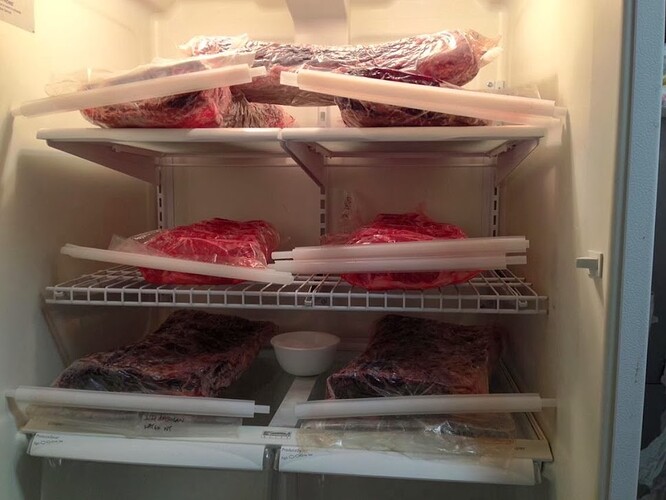After reading some of the interesting exploits by others here, I figure I will post my own little adventure over the last two years - dry aging beef at home. The concept is pretty simple and well known - leave the meat in the fridge and two things happen: 1) the water in the muscle evaporates over time and thus concentrates the flovor; 2) the enzymes in the muscles continue to break down the fibers and thus making the meat more tender. There are DIY articles online in how to do it.
Then I started thinking… people often drink verticals of the same wine to compare vintages. How about doing the same with dry aging meat? So over the past two years I started aging meat in varying periods of time, and started doing what I call “vertical steak tasting”.
My process of beef aging starts with a subprimal cut of beef, usually prime grade from Costco, but I have also done Wagyu from Snake River Farms, sourced from a friend who owns a few Japanese restaurants. Each subprimal starts at somewhere between 10 - 15lbs but I have done up to 20lbs. I use a dedicated fridge for this because the meat stinks (in a good way). There is a product called drybagsteak which is a special bag that supposingly let the moisture in the meat evaoporate but keep the germs out. Then it’s just leaving the beef in the fridge for a set period of time. I didn’t use a specialized fridge - it was just a really old fridge from sears. What you need is temperture in the loe 30s and low humidity so moisture evaporates from the meat (achieved with baking soda). At the end of the aging period I cut down the subprimal to steaks and cut away the dried up rind along the side. Then I vacuum seal each steak individually and freeze them quickly using dry ice. The idea of using dry ice is that the meat freezes so quickly that there is minimal damage to the muscle cells, and thus retains the juiciness of the steak as much as possible. After that, the steaks should keep well for 2 - 3 years in deep freeze.
When I cook the steaks it’s real easy. Since they are each already individually vacuum sealed, I just take them out of the freezer (or thawed in the fridge) and sous vide. Afterwards I either pan sear with ghee (butter), or throw it on my TEC infrared grill that goes up to 900F (as close as I can get to a real broiler at home).
My current inventory includes: prime NY and Rib Eye cut 15 / 28 / 35 / 42 / 49 / 63 / 77 / 100 / 130 days, Bone in Prime Rib Eye 42 / 49 days, and American Wagyu NY and Rib Eye cut 49 / 100 days. I built this up over about 1.5 years and over 20 subprimals. This had turned from an experiment into a passion.
When I do the tastings I always start with an unaged steak to establish baseline reference. Then I usually go in 2 week intervals, like 15 / 28 / 42 / 63 / 100, or 15 / 28 / 35 / 49 / 77 / 130, etc. I usually do one steak per couple and carve them into strips before serving, so people just get bites of different aged steak - again the inspiration comes from wine tasting. The idea is that as the meat ages the flavor continues to concentrate and get more intense, but the meat also continues to tenderize and thus loses the typical steak texture that people associate with.
I have done quite a few of these parties now and people tend to favor either the 15 or 28 days if they want more flavor. After 28 days the meat really loses the typical steak texture and many people are not used to that. However I have people who love the really aged ones. I even have one who though the 130 days aged was the best! Interestingly these people tend to be more experienced wine drinkers. I suspect they have a better trained palate to pick up different flavors in the aged meat. Some of these meat that had been aged for more than two months develop intense umami flavor that goes very well with mature bordeaux. My personal favorite is something in the 42 - 63 day range.
I didn’t keep track of cost, but I’d estimate around $20 a lb for prime. Costco sells them at around $11 a lb, I usually lose 40% of weight to aging and trim, and there is the cost to individaully vacuum seal the steaks and use dry ice to freeze. Depending on your perspective I guess that cost is either expensive or a huge bargain. Personally I have not been to a steak restaurant on my own dime for about 2 years now. Nothing else outside compares to what I have in my freezer at home. ![]()
